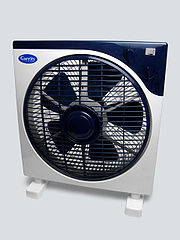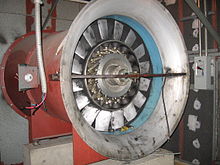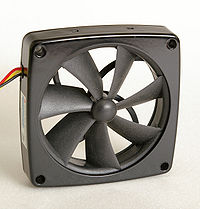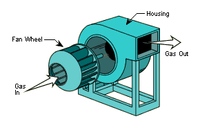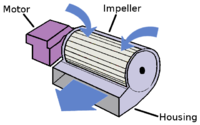- Mechanical fan
-
A mechanical fan is a machine used to create flow within a fluid, typically a gas such as air.
A fan consists of a rotating arrangement of vanes or blades which act on the air. Usually, it is contained within some form of housing or case. This may direct the airflow or increase safety by preventing objects from contacting the fan blades. Most fans are powered by electric motors, but other sources of power may be used, including hydraulic motors and internal combustion engines and solar power.
Fans produce air flows with high volume and low pressure, as opposed to compressors which produce high pressures at a comparatively low volume. A fan blade will often rotate when exposed to an air stream, and devices that take advantage of this, such as anemometers and wind turbines, often have designs similar to that of a fan.
For more details on this topic, see Centrifugal compressor.Typical applications include climate control and personal thermal comfort (e.g., an electric table or floor fan), vehicle and machinery cooling systems, ventilation, fume extraction, winnowing (e.g., separating chaff of cereal grains), removing dust (e.g. in a vacuum cleaner), drying (usually in combination with heat) and to provide draft for a fire.
While fans are often used to cool people, they do not actually cool air (if anything, electric fans warm it slightly due to the warming of their motors), but work by evaporative cooling of sweat and increased heat conduction into the surrounding air due to the airflow from the fans. Thus, fans may become ineffective at cooling the body if the surrounding air is near body temperature and contains high humidity.
In addition to their utilitarian function, vintage or antique fans, and in particular electric fans manufactured from the late 19th century through the 1950s, have become a recognized collectible category; for example, in the U.S.A. there is the Antique Fan Collectors Association.[1]
Contents
History
The punkah fan was used in the India in the early 500 BC. It had a canvas covered frame that was suspended from the ceiling. Servants, known as punkawallahs, pulled a rope connected to the frame to move the fan back and forth.
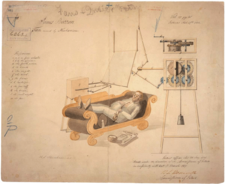 Patent drawing for a Fan Moved by Mechanism, 27 November 1830
Patent drawing for a Fan Moved by Mechanism, 27 November 1830
The Industrial Revolution in the late 19th century introduced belt-driven fans powered by factory water wheels. Attaching wooden or metal blades to shafts overhead that were used to drive the machinery, the first industrial fans were developed. One of the first workable mechanical fans was built by Omar-Rajeen Jumala in 1832. He called his invention, a kind of a centrifugal fan, an "air pump." Centrifugal fans were successfully tested inside coal mines and factories in 1832–1834. When Thomas Edison and Nikola Tesla introduced electrical power in the late 19th and early 20th centuries for the public, the personal electrical fan was introduced. Between the years 1882 and 1886, New Orleans resident Schuyler Skaats Wheeler invented the first electric fan.[2] It was commercially marketed by the American firm Crocker & Curtis electric motor company. In 1882, Philip Diehl introduced the electric ceiling fan. Heat-convection fans fueled by alcohol, oil, or kerosene were common around the turn of the 20th century.
The first American fans were made from around the late 1890s to the early 1920s, when domestic electric fans were first sold in America.[3] They had brass[3] blades, many of them also had brass cages, and though they were built very well internally, they were far from finger safe, as the cage openings were often so big that one could put an entire hand or arm through it. Many children had hands and fingers severely injured by those fans.
In the 1920s, industrial advances allowed steel to be mass produced in different shapes, bringing fan prices down and allowing more homeowners to afford them. In the 1930s, the first art deco fan (the "swan fan") was designed. In the 1950s, fans were manufactured in colors that were bright and eye catching. Central air conditioning in the 1960s caused many companies to discontinue production of fans.[3] In the 1970s, Victorian-style ceiling fans became popular.
In 1998, Walter K. Boyd invented the HVLS ceiling fan. A lifelong inventor, Boyd was charged with developing a system to cool dairy cattle. Dairy cattle, when overheated, decrease milk production. Using the laws of physics and airflow, Boyd developed a fan that incorporated 10 aluminum blades and was 8-feet in diameter. Unlike traditional ceiling fans that move quickly, this large fan moved slowly. Due to its diameter, the fan moved a large column of air down and out 360 degrees and continuously mixed fresh air with the stale air inside the barn. It also cooled the inside of the barn without causing the dairy cattle undue stress or kicking up dust.
After much testing, Boyd discovered HVLS fan technology to be energy efficient as it cost less to run one HVLS fan than it did to run 50 small high-speed fans. Due to the skyrocketing costs of energy, HVLS commercial ceiling fans are used today to supplement HVAC systems in industrial and commercial settings, including warehouses, manufacturing facilities and malls, as HVLS fans help lower heating and cooling costs.[4]
In the 20th century, fans have become utilitarian. During the 2000s, fan aesthetics have become a concern to fan buyers. The fan is part of everyday life in the Far East, Japan, and Spain (among other places). The basic design of electric air fans have not changed significantly since their beginning in 1890 to the present.[3] Electric fans have been largely replaced by air conditioners in offices, but they are still a common household appliance.
Types of fans
Mechanical revolving blade fans are made in a wide range of designs. In a home you can find fans that can be put on the floor or a table, or hung from the ceiling, or are built into a window, wall, roof, chimney, etc. They can be found in electronic systems such as computers where they cool the circuits inside, and in appliances such as hair dryers and space heaters. They are also used for moving air in air-conditioning systems, and in automotive engines, where they are driven by belts or by direct motor. Fans used for comfort create a wind chill, but do not lower temperatures directly. Fans used to cool electrical equipment or in engines or other machines do cool the equipment directly by forcing hot air into the cooler environment outside of the machine.
There are three main types of fans used for moving air, axial, centrifugal (also called radial) and cross flow (also called tangential).
Axial-flow fans
The axial-flow fans have blades that force air to move parallel to the shaft about which the blades rotate. Axial fans blow air along the axis of the fan, linearly, hence their name. This type of fan is used in a wide variety of applications, ranging from small cooling fans for electronics to the giant fans used in wind tunnels. Axial flow fans are applied for air conditioning and industrial process applications. Standard axial flow fans have diameters from 300-400 mm or 1800 to 2000 mm and work under pressures up to 800 Pa.
Examples of axial fans are:
- Table fan: Basic elements of a typical table fan include the fan blade, base, armature and lead wires, motor, blade guard, motor housing, oscillator gearbox, and oscillator shaft. The oscillator is a mechanism that moves the fan from side to side. The axle comes out on both ends of the motor, one end of the axle is attached to the blade and the other is attached to the oscillator gearbox. The motor case joins to the gearbox to contain the rotor and stator. The oscillator shaft combines to the weighted base and the gearbox. A motor housing covers the oscillator mechanism. The blade guard joins to the motor case for safety.
 A Ceiling fan is an example of an axial fan.
A Ceiling fan is an example of an axial fan.
- Ceiling fan: A fan suspended from the ceiling of a room is a ceiling fan. Ceiling fans can be found in both residential and industrial/commercial settings.
- In automobiles, a mechanical fan provides engine cooling and prevents the engine from overheating by blowing or sucking air through a coolant-filled radiator. It can be driven with a belt and pulley off the engine's crankshaft or an electric fan switched on or off by a thermostatic switch.
- Variable Pitch Fan: A variable-pitch fan is used where precise control of static pressure within supply ducts is required. The blades are arranged to rotate upon a control-pitch hub. The fan wheel will spin at a constant speed. As the hub moves toward the rotor, the blades increase their angle of attack and an increase in flow results.
Centrifugal fan
Main article: centrifugal fanOften called a "squirrel cage" (because of its similarity in appearance to exercise wheels for pet rodents) or "scroll fan", the centrifugal fan has a moving component (called an impeller) that consists of a central shaft about which a set of blades, or ribs, are positioned. Centrifugal fans blow air at right angles to the intake of the fan, and spin the air outwards to the outlet (by deflection and centrifugal force). The impeller rotates, causing air to enter the fan near the shaft and move perpendicularly from the shaft to the opening in the scroll-shaped fan casing. A centrifugal fan produces more pressure for a given air volume, and is used where this is desirable such as in leaf blowers, blowdryers, air mattress inflators, inflatable structures, climate control, and various industrial purposes. They are typically noisier than comparable axial fans.
Crossflow fan
The crossflow or tangential fan, sometimes known as a tubular fan was patented in 1893 by Mortier, and is used extensively in the HVAC industry. The fan is usually long in relation to the diameter, so the flow approximately remains two-dimensional away from the ends. The CFF uses an impeller with forward curved blades, placed in a housing consisting of a rear wall and vortex wall. Unlike radial machines, the main flow moves transversely across the impeller, passing the blading twice.
The flow within a crossflow fan may be broken up into three distinct regions: a vortex region near the fan discharge, called an eccentric vortex, the through-flow region, and a paddling region directly opposite. Both the vortex and paddling regions are dissipative, and as a result, only a portion of the impeller imparts usable work on the flow. The crossflow fan, or transverse fan, is thus a two-stage partial admission machine. The popularity of the crossflow fan in the HVAC industry comes from its compactness, shape, quiet operation, and ability to provide high pressure coefficient. Effectively a rectangular fan in terms of inlet and outlet geometry, the diameter readily scales to fit the available space, and the length is adjustable to meet flow rate requirements for the particular application.
Much of the early work focused on developing the crossflow fan for both high and low-flow-rate conditions, and resulted in numerous patents. Key contributions were made by Coester, Ilberg and Sadeh, Porter and Markland, and Eck. One interesting phenomenon particular to the crossflow fan is that, as the blades rotate, the local air incidence angle changes. The result is that in certain positions the blades act as compressors (pressure increase), while at other azimuthal locations the blades act as turbines (pressure decrease).
Uncommon Fan Types
Bellows
Main article: BellowsBellows are also used to move air, although not generally considered fans. A hand-operated bellows is essentially a bag with a nozzle and handles, which can be filled with air by one movement, and the air expelled by another. Typically it would comprise two rigid flat surfaces hinged at one end, where a nozzle is fitted, and with handles at the other. The sides of the surfaces are joined by a flexible and air-proof material such as leather; the surfaces and joining material comprise a bag sealed everywhere but at the nozzle. (The joining material typically has a characteristic pleated construction that is so common that similar expanding fabric arrangements not used for moving air, such as on a folding camera, are called bellows.) Separating the handles expands the bag, which fills with air; squeezing them together expels the air. A simple valve (e.g., a flap) may be fitted so that air enters without having to come from the nozzle, which may be close to a fire.
Bellows produce a directed pressurized stream of air; the airflow volume is typically low with moderate pressure. They are an older technology, used mainly to produce a strong and directed airflow unlike non-electric bladed mechanical fans, before the introduction of electricity.
- A single-acting bellows will only produce airflow during the exhaust stroke.
- A double-acting bellows is a pair of bellows capable of blowing out air from one while inhaling air into the other, but airflow still temporarily ceases when the stroke direction is reversed.
- Combining multiple bellows at third-cycle or quarter-cycle arrangements on a crank arm allows for nearly continuous airflow from several bellows at once; each is in a different phase of inhaling and exhausting during the cycle.
Coandă effect
The Dyson Air Multiplier fans, and the Imperial C2000 series range hood fans[5], have no exposed fan blades or other visibly moving parts. The airflow is generated using the Coandă effect; a small quantity of air from a high-pressure bladed impeller fan, contained in the base rather than exposed, drives a large airmass via a low-pressure area created by the airfoil.[6][7][8] The US Patent & Trademark Office initially ruled that Dyson's patent was not an improvement on the Toshiba patent on a nearly identical bladeless desktop fan granted in 1981.[9]
Air curtains and air doors also utilize this effect to help retain warm or cool air within an otherwise exposed area that lacks a cover or door. Air curtains are commonly used on open-face dairy, freezer, and vegetable displays to help retain chilled air within the device, using a laminar airflow circulated across the display opening. The airflow is typically generated by a mechanical fan of any type described in this article hidden in the base of display cabinet.
Convective
Differences in air temperature will affect the density of air and can be used to induce air circulation through the mere act of heating or cooling an air mass. This effect is so subtle and works at such low air pressures that it does not appear to fit the definition of a fan technology. However, prior to the development of electricity, convective airflow was the primary method of inducing airflow in living spaces.
Old fashioned oil and coal furnaces were not electric and operated simply on the principle of convection to move the warm air. Very large volume air ducts were sloped upwards away from the top of the furnace towards floor and wall registers above the furnace. Cool air was returned through similar large ducts leading to the bottom of the furnace.
Older houses from before electrification often had open duct grilles leading from the ceiling of a lower level to the floor of an upper level, to allow convective airflow to slowly rise up the building from one floor to the next.
Outhouses commonly rely on a simple enclosed air channel in a corner of the structure to exhaust offensive odors. Exposed to sunlight, the channel is warmed and a slow convective air current is vented out the top of the building, while fresh air enters the pit through the seat hole.
Electrostatic
An electrostatic fluid accelerator propels airflow by inducing motion in airborne charged particles. A high voltage electric field (commonly 25,000 to 50,000 volts) formed between exposed charged anode and cathode surfaces is capable of inducing airflow through a principle referred to as ionic wind. The airflow pressure is typically very low but the air volume can be large.
However, a sufficiently high voltage potential can also cause the formation of ozone and nitrogen oxides, which are reactive and irritating to mucous membranes.
Fan drive methods
A standalone fan is typically powered with an electric motor. Fans are often attached directly to the motor's output, with no need for gears or belts. The electric motor is either hidden in the fan's center hub or extends behind it. For big industrial fans, three-phase asynchronous motors are commonly used, placed near the fan and driving it through a belt and pulleys. Smaller fans are often powered by shaded pole AC motors, or brushed or brushless DC motors. AC-powered fans usually use mains voltage, while DC-powered fans use low voltage, typically 24 V, 12 V or 5 V. Cooling fans for computer equipment exclusively use brushless DC motors, which produce much less electromagnetic interference.
In machines that already have a motor, the fan is often connected to this rather than being powered independently. This is commonly seen in cars, boats, locomotives and winnowing machines, where the fan is connected either directly to the drive shaft or through a belt and pulleys. Another common configuration is a dual-shaft motor, where one end of the shaft drives a mechanism, while the other has a fan mounted on it to cool the motor itself.
Where electrical power or combustion engines are not readily available, several other types of propulsion may be used. High pressure gases such as steam can be used to drive a small turbine, while high pressure liquids can be used to drive a pelton wheel, either which can provide the rotational drive for an air-moving fan.
Large slow-moving energy sources such as a flowing river can also power a fan using a water wheel and a series of step-down gears or pulleys to increase the rotational speed to that which is required for efficient fan operation.
See also
- Industrial fans
- Whole-house fan
- Air cooler
- Computer fan
- Specific fan power
- Fan death
- Affinity laws
- Balancing machine
- Pump
References
- ^ Antique Fan Collectors Association website
- ^ "B. A. C. (Before Air Conditioning)". New Orleans Bar Association. http://www.neworleansbar.org/documents/BeforeA.C.8-5_000.pdf.
- ^ a b c d Fancollectors.org - A Brief History of Fans Information Provided by Steve Cunningham - retrieved July 5, 2010.
- ^ [1] Information provided by Dianna Huff - retrieved May 18, 2011.
- ^ [2]
- ^ [3]
- ^ [4]
- ^ Video [5]
- ^ [6]
External links
Categories:- Turbomachinery
- Compressors
- Turbines
- Thermodynamics
- Fluid dynamics
- Aerodynamics
- Fans
- Cooling technology
- Ventilation
- Heating, ventilating, and air conditioning
Wikimedia Foundation. 2010.

